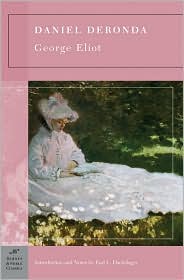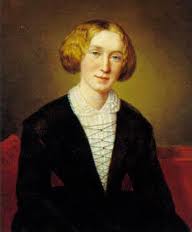“Visions are the creators and feeders of the world. I see. I measure the world as it is, which the vision will create anew.“
 In what may be her most exciting and original novel, George Eliot weaves two completely different plots, one of which is a uniquely sympathetic and fully developed story with Jewish protagonists. Presenting no Jewish stereotypes, as we see in Dickens (in Oliver Twist and other novels) and even Trollope (with The Way We Live Now (Barnes & Noble Classics)), she depicts characters who have, in one case, tried to avoid their heritage and in another have been drawn irrevocably to a religion and culture with which they have had no previous contact.
In what may be her most exciting and original novel, George Eliot weaves two completely different plots, one of which is a uniquely sympathetic and fully developed story with Jewish protagonists. Presenting no Jewish stereotypes, as we see in Dickens (in Oliver Twist and other novels) and even Trollope (with The Way We Live Now (Barnes & Noble Classics)), she depicts characters who have, in one case, tried to avoid their heritage and in another have been drawn irrevocably to a religion and culture with which they have had no previous contact.
Daniel Deronda, a young man who has been brought up as an English gentleman by Sir Hugo Mallinger, has never known his real parents, secretly fearing that he is illegitimate. As time passes, he longs to understand the circumstances of his birth, especially after Sir Hugo marries and produces heirs of his own. Beautiful Gwendolen Harleth, selfish and manipulative, is romantically attracted to Daniel, but a sudden change in her family’s financial status leads her into a precipitous but financially advantageous marriage to the arrogant Henleigh Grandcourt. Meanwhile, Daniel saves a young woman from drowning herself, a singer named Mirah Lapidoth who is in despair. Mirah, a Jew, has been stolen from her family by her father, whom she suspects planned to sell her into white slavery, and she desperately misses her mother and brother, whom she can no longer find. As she progresses with her singing career, she never forgets her heritage, of which she is inordinately proud.
financially advantageous marriage to the arrogant Henleigh Grandcourt. Meanwhile, Daniel saves a young woman from drowning herself, a singer named Mirah Lapidoth who is in despair. Mirah, a Jew, has been stolen from her family by her father, whom she suspects planned to sell her into white slavery, and she desperately misses her mother and brother, whom she can no longer find. As she progresses with her singing career, she never forgets her heritage, of which she is inordinately proud.
As Eliot develops the various social settings of this fascinating novel, written in 1876, a full picture of British society evolves. To protect Mirah from her father and her own despair, Daniel places her in the home of friends and resolves to try to find her family. When Daniel discovers her brother Mordecai, a Jewish mystic and seer, Mordecai is convinced, against all odds, that Daniel is Jewish–and is the person who will carry his visions for a Jewish nation to fruition. As the novel develops further, Eliot explores Jewish mysticism, religious traditions, and cultural heritage, even as she also uses the shallow, aristocratic life of Gwendolen Harleth Grandcourt as a contrast to that of Mirah.
The novel is uniqu e in its favorable and lengthy depiction of Judaism and in its illustration of Judaism’s cultural superiority to superficial, aristocratic British life. Mirah and her family take center stage in terms of sympathy, despite the fact the Gwendolen, who in other novels might have been the heroine, suffers terribly in her miserable marriage to Grandcourt. Daring to do something completely different with this complex novel, which was her last, Eliot’s vision and seriousness of purpose here created enormous controversy in its time and presaged a new direction for the novel.
e in its favorable and lengthy depiction of Judaism and in its illustration of Judaism’s cultural superiority to superficial, aristocratic British life. Mirah and her family take center stage in terms of sympathy, despite the fact the Gwendolen, who in other novels might have been the heroine, suffers terribly in her miserable marriage to Grandcourt. Daring to do something completely different with this complex novel, which was her last, Eliot’s vision and seriousness of purpose here created enormous controversy in its time and presaged a new direction for the novel.
Notes: The BBC has produced a dramatization of this novel in five episodes.
Also reviewed here: MIDDLEMARCH and MILL ON THE FLOSS
